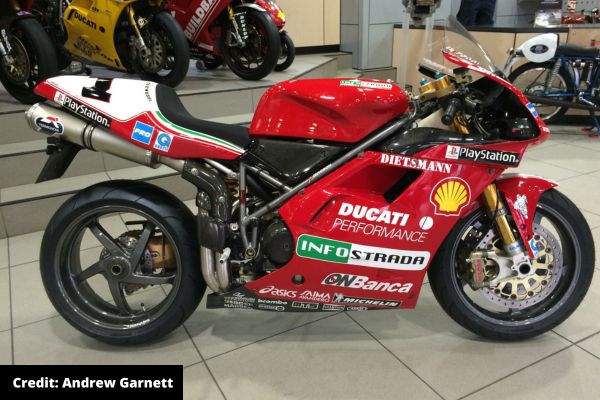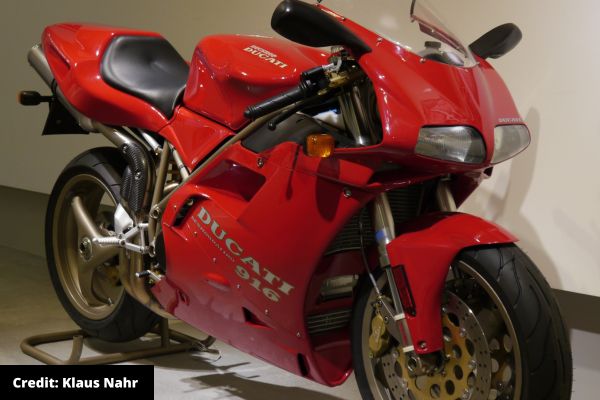Ducati 916: The motorcycle that changed the world
The 916 made Ducati a bedroom wall pin-up when it launched in 1994. How much does the Italian motorcycle maker owe to this superbike champion?
Ducati is a now a two-wheeled household name in the same manner as Ferrari, and the Italian motorcycle maker owes it all to one bike – the 916.
Launched in 1994, the 916 took Ducati from the choice of connoisseurs to bedroom wall pin-up. On looks alone, the 916 was a winner thanks to its lithe form, sculpted twin headlights, and exhausts neatly tucked under the tail. Yet all of this and more was form following function with a focus on taking the top step of the podium in the Superbike World Championship.
Ducati had already enjoyed plenty of success in this series with rider and manufacturer titles with its 851 and 888 bikes. However, none of this had translated into worldwide attention and sales beyond the Ducati faithful. All that was about to change in 1994 when British rider Carl Fogarty slung a leg over the new 916.
It was the first superbike to get on terms in showrooms with the Honda Fireblade, which had stunned the world in 1992 with its compact size and agility. Ducati’s answer was a new trellis frame for the 916, painted in a subtle gold, and a 916cc V-twin engine that was about thumping low- and mid-rev shove rather than outright power at screaming revs. Even so, the 916’s motor was good for 114bhp in road trim at its launch.

The racing version had capacity increased to 955c to make the most of the regulations and delivered 126bhp in the SP model used to homologate the race bike. The SP also featured exotic Ohlins suspension, a new airbox, and larger valves to make the most of its greater capacity.
The effect of these changes was instant as Fogarty won the first round of the 1994 season at Donington Park. However, he didn’t have it all his own way as Scott Russell on a Kawasaki fought every inch of the way. In the end, though, Fogarty won 10 of the 22 races that made up the 1994 championship to lift the title for himself and Ducati. By the end of the last race at Australia’s Phillip Island track, Fogarty’s piercing stare was every bit as famous as the slender red Ducati superbike.
In a single race season, Ducati had transcended from a little-known Italian motorcycle manufacturer to an object of desire recognised by millions around the world. The effect it had on sales was sensational and the 916 was routinely sold out with lengthy waiting lists. A measure of how sought-after it became is that plenty were bought by people who had never owned a motorcycle or even had a licence – they just wanted the bike as a piece of art.

It's easy to see why a 916 could grace a gallery space when you take in its lines and get up close to the individual components. Even the basic road bike was made with an attention to detail that only the most exotic Japanese factory homologation specials could match. The simple three-spoke alloy wheels finished in the same delicate gold at the thin-tube triangulated frame looked great, while the single-sided rear swingarm was another touch of genius. It was there to make wheel changes quicker for the race versions, but it also gave the road machine a clean, purposeful look that only Honda’s hugely expensive and rare NR750 could match.
Elsewhere, the V-twin engine’s exhausts hugged their way from the motor and up the rear of the chassis to exit under the seat unit in not one but two pipes. All of this was wrapped in slim body panels with elegant lines and those trademark twin lights in the front fairing. No wonder the 916 scooped every ‘motorcycle of the year’ award in 1994 for road bikes.
All of this gave the Ducati 916 showroom appeal like no other, but it was only when you rode this bike did you fully appreciate just how special it was. Other than the Fireblade, superbikes up to this point had been bruisers with big engines to give them equally big top speeds. Handling and agility were secondary considerations. Not so with the Ducati, which made a virtue of its diminutive size and low weight. Being so slender, it could lean into corners like no other, which could take a little getting used to but soon encouraged the rider to carry momentum into and out of bends in a way that was impossible on a contemporary roadgoing superbikes from Kawasaki, Suzuki or Yamaha.

Sure, these Japanese machines made more power than the 916, but again the Ducati’s size and lower weight played into the Italian’s hands. There was also much more urge from the 916cc V-twin engine than its rivals’ inline four-cylinder motors. This gave the 916 amazing drive out of corners, finding traction on even the slipperiest exit. Couple that to the superb front end grip, strong brakes, and a general air of unflappable competence, and the Ducati was the bike to beat for Sunday morning blasts. It wasn’t quite so good at all-day touring due to its high pegs and canted forward riding position, but nobody was bothered by that.
Back on the track, Carl Fogarty added another World Superbike title to his first with a follow-up win in 1995. Troy Corser gave the 916 its hat-trick in 1996, and Fogarty gained his own triple in 1998 on the 916 before making it four championship wins in 1999 on a Ducati 996, which was a derivative of the 916. In the UK, Steve Hislop also won the 1995 British Superbike Championship on a 916.
From there, Ducati never looked back and several versions of the 916 appeared, such as the Senna edition, Strada with pillion seat, SPS, and Carl Fogarty replica. Then, in 1999, Ducati updated the bike to the 996 model with its larger engine but near identical styling that lasted until 2004. All are sensational to ride or just to stare at in the garage, and owning one is a privilege knowing this is a motorcycle that changed the world.
Do you own a Ducati 916? How does it compare to other bikes? Let us know in the comments!
I have a 916 Has 40000 miles on it Just lucky to have bought it Will be my last bike for sure. Age 75 Had 7. Down to 2. 999s also
Ducati john, 22/03/2024

I have owned my 916 for many years. I love the original style graphics, it’s a ‘97 model. The looks are still stunning and the noise the engine makes is like no other bike in my opinion, the exhaust note is addictive. I’m also content just to look at it.
Red, 28/10/2023
COMMENT